Contents
If you want a quick escape to nature, head to Algonquin Provincial Park and spend a few nights camping under the stars. Wake on the shores of a tranquil lake. Sit around a campfire and watch the smoke drift up through the trees. Listen to the loons calling and the wolves howling as you drift off to sleep.
Algonquin Provincial Park is the most popular park in Ontario for camping, with plenty of campgrounds to accommodate a large number of campers. Most of these are set along the Highway 60 corridor, about three hours north of Toronto, where many of the hiking trails are located. Also in the vicinity are a restaurant, store, and bike rental shop, which add an element of simplicity to the whole experience.

Achray Campground is a beautiful spot on the east side of the park off the Trans-Canada Highway (417) and draws campers coming from Ottawa, about three hours away, and other areas east of the park.
Campgrounds range from large, busy, and energetic to small, quiet, and peaceful. Families often prefer the larger campgrounds with nice beachfront areas, while nature lovers opt for the smaller campgrounds or those that provide more privacy between sites.
Regardless of your preference, if you are camping between early July and the first week of September, the campgrounds are very busy and you will definitely want to make reservations well in advance. To sort through the options, see our list of the best campgrounds in Algonquin.
1. Lake of Two Rivers Campground
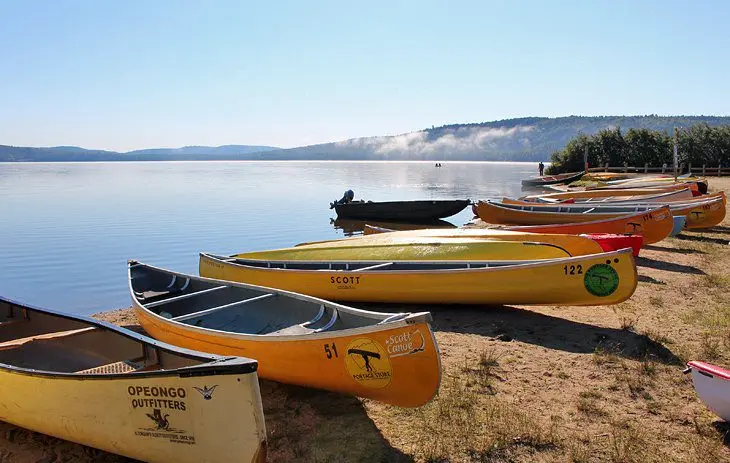
With a prime location along Highway 60, Lake of Two Rivers has the most beautiful campground setting in the entire park. Huge pine trees tower over campsites, and a long stretch of soft sand along the shores of Lake of Two Rivers fronts the campground. Running along the edge of the campground is the Madawaska River.
You can rent canoes and paddle out from the beach to explore the lake or the river. A roped off swimming area is perfect for kids and families. On the edge of the campground is the Two Rivers Store, with groceries and supplies, a restaurant and ice cream shop, and bike rentals.
This is a large campground with 241 sites, many of which are electrical. Most of the sites are extremely large.
The two loops near the beach are very open, with little to no privacy between sites but offer easy access to the waterfront. The two loops farther back offer much nicer campsites with undergrowth below the pines that offer some visual obstruction between sites. The farther back you go, the quieter the sites, with more undergrowth and greater privacy.
During the peak times of July and August, including the Labour Day weekend, this campground is busy, and due to the volume of campers, it can be quite noisy. It has a boisterous feel, so if you are looking for a quiet, woodsy experience, it’s best to try a smaller campground.
If you are coming here mid-week in the spring or fall, this campground is perfect, with fewer campers and beautiful, quiet surroundings.
2. Pog Lake Campground
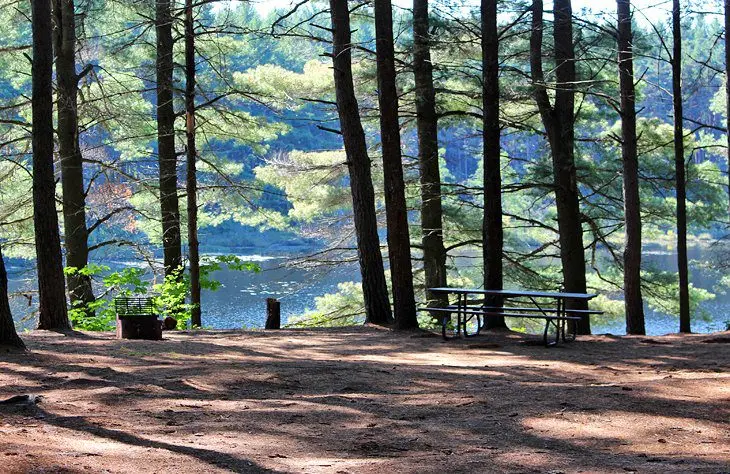
Pog Lake Campground has a lovely setting along a section of shoreline on Pog Lake and the Madawaska River, just a short drive off Highway 60. Sites are very large, dispersed between mature pine trees, and many of the sites have beautiful views. Undergrowth between sites lends to the privacy. It’s hard to go wrong finding a site in this campground.
Section C, which is surrounded on three sides by water, both by Pog Lake and the Madawaska River, offers quiet, private, well-spaced sites, perfect for those looking for peace and tranquility, but is quite a distance to the beach area.
Section A is where the main beach is located and is a good area for families wanting access to swimming areas. Waterfront sites, which run from approximately sites 107 to 112, are open and offer little privacy but have a good view out to the water and easy access to the beach. The beach here is shallow and great for children.
Pog has a mix of electrical and non-electrical sites, as well as a radio- and pet-free area for those looking to escape noise.
Also of note is the Old Railway Bike Trail, which can be easily accessed from the Pog Lake Campground. From here, you can bike the Lake of Two Rivers Campground and Two Rivers Store, and beyond to the Track and Tower hiking trail. Heading in the opposite direction, you can also bike to Whitefish Lake; the Coon Lake Campground; and Rock Lake, where the Booth’s Rock hiking trail begins.
3. Achray Campground
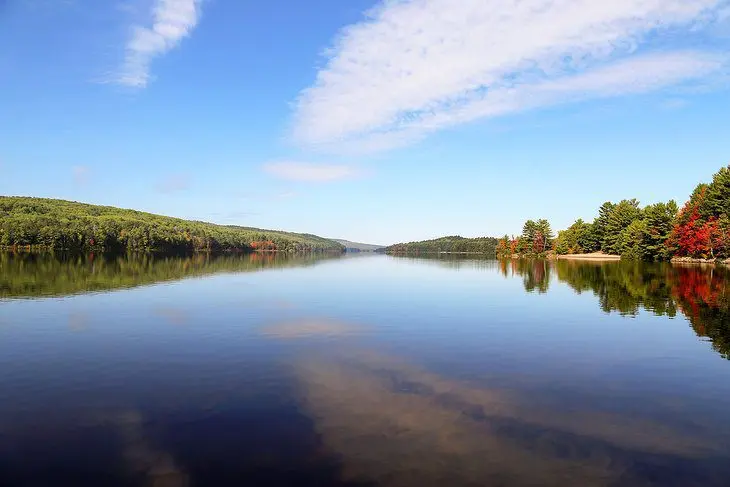
This beautiful campground on the east side of Algonquin Provincial Park is set along a lovely stretch of shoreline on Grand Lake, with nice beach areas.
Canada’s famous Group of Seven artist, Tom Thompson, visited and also worked as a fire ranger in this area between 1913 and 1916. Several of his paintings were inspired from the landscape around Grand Lake, including the oil painting, The Jack Pine.
Located about 50 kilometers down a gravel road off the Trans-Canada Highway (Hwy 417), the campground has a remote feel. The 45 campsites in this campground are well spaced and many are waterfront.
Many campers come here to canoe or kayak. You can paddle out on Grand Lake and portage into nearby lakes for day trips. Alternatively, you can set up a chair on the beach and spend the day soaking up the sun. Nearby are a number of hiking trails, including the spectacular 1.5-kilometer Barron Canyon Trail that looks out over the 100-meter walls of the Barron Canyon. This is one of the best hikes in Algonquin Park.
This campground is most convenient for campers coming from destinations east of the park, like Ottawa, rather than Toronto. The drive to Achray from Toronto is more than 5.5 hours but from Ottawa, the travel time is about three hours.
4. Mew Lake Campground
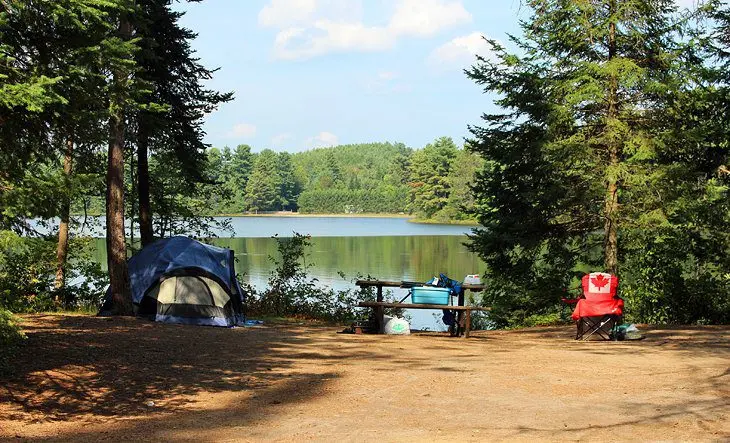
Mew Lake Campground has a quiet feel, with a mix of waterfront sites and forest sites. The vegetation here is primarily small pine trees and a good amount of ground cover for privacy. Sites are large and well-spaced, and for the most part, they do not back on to other sites but on to wooded areas or water.
From this campground, you can access the Old Railway Bike Trail, which leads to the Track and Tower hiking trail, as well as other lakes. Unfortunately, the campground is very close to Highway 60, so traffic noise can be a problem for light sleepers.
Mew Lake Campground also has a number of yurts available for rent.
5. Kearney Lake Campground

The closest campground to the East Gate on Highway 60, Kearney Lake Campground has 104 sites, many of which front the lake or wetland areas. This is a great campground for people who are looking to enjoy nature in a tranquil, rustic setting.
Sites are small and designed to accommodate tents, and there are no electrical sites. While there is a comfort station with washrooms and showers in the 201 to 243 loop, the rest of the facilities are simply pit toilets.
The campground is set on Kearney Lake, and both loops offer a range of waterfront sites. Waterfront sites in the 201 to 243 loop are outstanding, with lovely views to the lake.
6. Canisbay Lake Campground
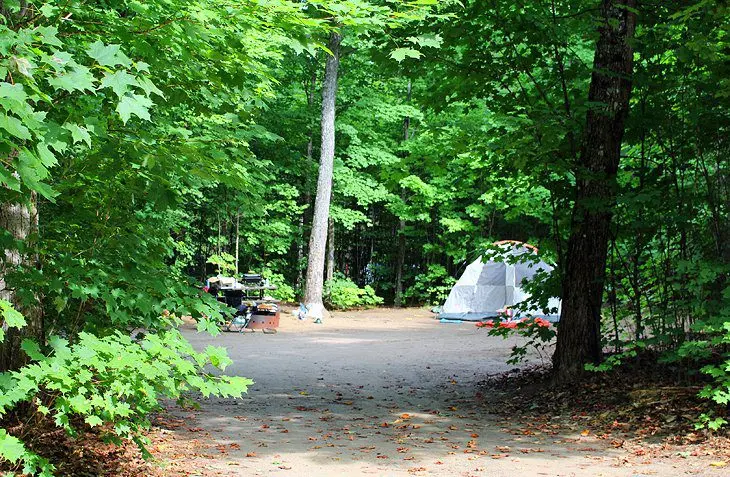
On the shores of Canisbay Lake, just off Highway 60 near the Track and Tower Hiking Trail, this campground has a different setting than many of the other campgrounds in the park. The trees here are deciduous, making it a good option for fall camping when the leaves are changing color.
Most of the campsites are in forested loops rather than waterfront. The campground has a total of 242 sites, with electrical, non-electrical, and radio and pet-free zones. Despite the large number of sites, the campground does not feel crowded or even large. The loops are well separated, and many of the sites are well spaced.
The abundance of leaves, unlike the sites dominated by pines, provide a visual barrier and block some of the surrounding noise of other campers. Most sites here are medium size.
7. Rock Lake Campground
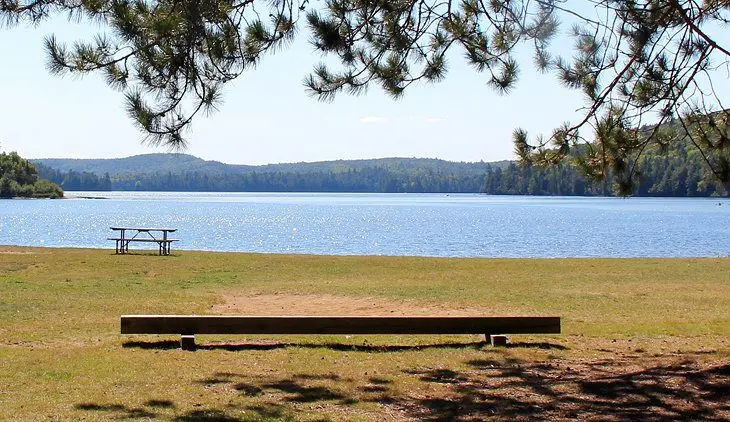
Rock Lake Campground is set eight kilometers off Highway 60, making it a bit less convenient for hikers, but a good option for canoers and kayakers. From the beach, you can paddle out on Rock Lake and the waterways beyond.
The electrical area of Rock Lake, which looks out to a glorious stretch of lake and the beachfront, offers almost no privacy between sites. Sites are small, and many people come here with RVs, making that whole area seem like a parking lot when it’s busy.
The non-electrical sites, in a different loop, offer a little more privacy but are still relatively small. The real advantage to camping here is access to the lake.
Nearby is Coon Lake Campground, with very little by way of scenery or atmosphere.
8. Tea Lake
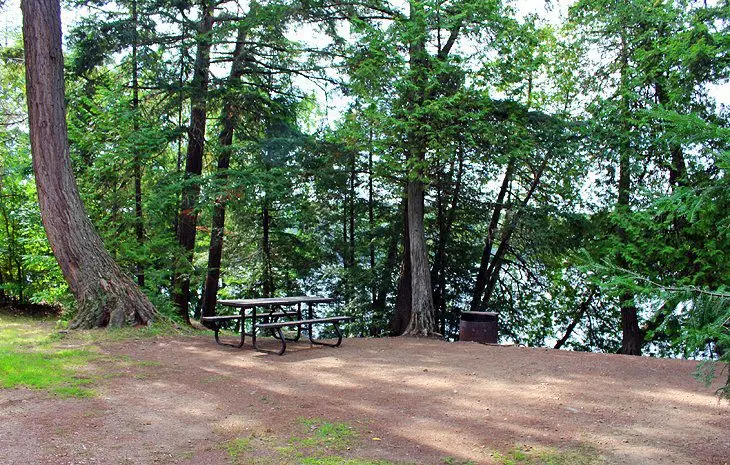
Tea Lake is the first campground you come to in the park when entering from the West Gate along Highway 60. Its location, far from the main hikes and activity at the center of the park, makes it feel a little removed. However, if you want a small, quiet campground, this is an option, although it lacks some visual appeal.
There are only 42 sites, all of which are non-electrical. The sites are small and basic. Many of the sites are waterfront, but views are mostly obscured by cedar trees that line the bank. Facilities here are great, with showers and flush toilets.
Camping at Tea Lake is a good option if you are planning on canoeing, with access to Canoe Lake and Smoke Lake, or if you are heading out on the Western Uplands Backpacking Trail, about eight kilometers west of here.
9. Kiosk
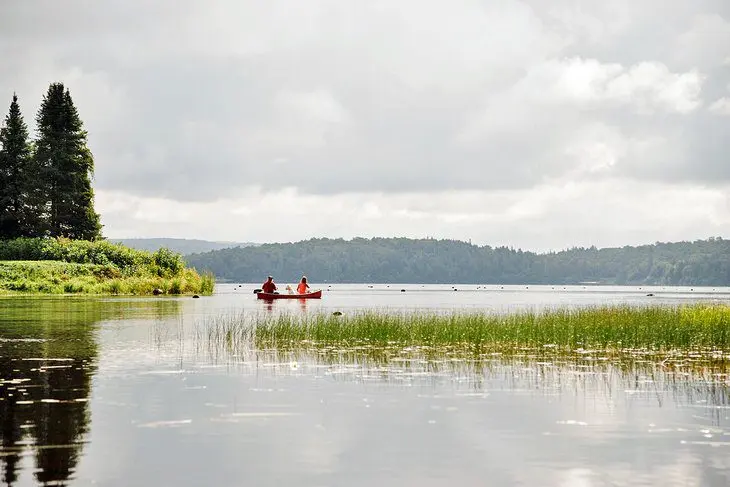
If you find yourself in the northern part of Algonquin Park, a couple of camping options exist, one of which is the small Kiosk campground. With only 24 sites, this campground has a cozy feel and has a different vibe than the much larger campgrounds located along the Highway 60 corridor.
The campground is set on beautiful Kioshkokwi Lake, one of the larger lakes in the park. You’ll find a decent beach here, and about half of the sites are near or on the waterfront. Note that sites 18-26 require a bit of a walk to get to the beach area.
Facilities here are fairly basic, with a mix of vault and flush toilets; no showers are available. This is truly a place to disconnect. At the time of writing, mobile phones do not work in this area of the park.
Many people use the Kiosk campground as a jumping-off point for canoe trips in the northern part of the lake, so sites tend to turn over fairly quickly. If you have a boat with a motor of less than 10 horsepower, you are allowed to use it on the lake.
Camping Details
Reservations can be booked up to five months in advance through the Ontario Parks online reservation system or by phone. If you are planning on camping in July or August, you will need to make a reservation to be sure to secure a campsite. Campsites can be reserved for a maximum of 23 consecutive nights. Canceling reservations less than four months out will incur a fee.
Securing a campsite for your preferred dates can be a challenge. It’s best to set an alarm and be on the website the moment the booking window for your date becomes available. The challenge of getting your site or dates is that people can stay for up to 23 days – and many do. Try your best but be prepared to be flexible.
Map of Campgrounds in Algonquin Provincial Park
More Related Articles on PlanetWare.com
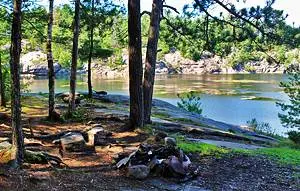
Ontario Outdoors: Another popular camping area in Ontario is Killarney Provincial Park. For more information see our article on the Best Camping Areas in Killarney Provincial Park. Hikers can find the best trails in Algonquin with our article on the Best Hikes in Algonquin Provincial Park or check out some trails to the north with our Best Hikes in Killarney Provincial Park article.
Investigate other parks you might enjoy with Top-Rated Ontario Parks: Exploring Ontario’s Great Outdoors.









